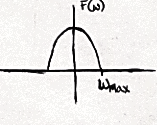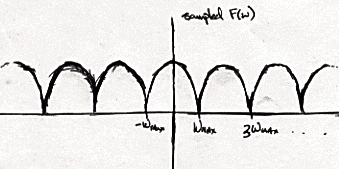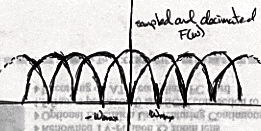
4A. (5 points) Assume you are given a band-limited function, F(w). What does it mean to say that the function is sampled at the Nyquist frequency? How is the Nyquist frequency related to the maximum frequency of the function.
Suppose WMax is the maximum frequency of the function. In this case the Nyquist frequency is 2*WMax. By the Shannon sampling theorem, a function sampled at or above the Nyquist frequency can be perfectly reconstructed from its sampled representation. Graph in the frequency domain the result of sampling F(w) at its Nyquist frequency. Let the following graph represent F(w) before sampling:

Notice that F(w) has been band-limited - the hump is zero beyond |w| > Wmax.After the function has been sampled at the Nyquist frequency we obtain the following graph in the frequency domain:

This graph was the answer to this part of the question. Notice in particular that the humps abut one another but do not overlap. This is because we are sampling a band-limited at the Nyquist frequency.
4B. (5 points) Suppose you decimate the sampled function. That is you remove every other sample. What does the resulting spectra look like?
Decimating the sampled function is the same as throwing away every other sample. This is equivalent to sampling the function at half the original frequency and in the frequency domain this simply shifts the humps closer together. Note that this does not increase or decrease the width of the humps. Here is the graph:

Many people made the mistake of thinking that decimation would either shift the humps farther apart rather than closer together, or cause every other hump to be removed.
4C. (5 points) What artifacts are introduced into the signal by this process of decimation described in 4B? How would you alleviate those artifacts?
Since the humps now overlap we will see aliasing artifacts. We can alleviate the aliasing artifact by pre-filtering the original function by a low-pass with width = Wmax/2. Then when the functions are sampled at half the Nyquist frequency they will no longer overlap. Note that these is no way to post-filter or interpolate in order to alleviate the aliasing artifact.4D. (5 points) Suppose you sample the original function at twice the Nyquist frequency and then decimate the result. What does the resulting spectra look like? Are there any artifacts introduced in this case?
Sampling at twice the Nyquist frequency and then decimating exactly the same as sampling at the Nyquist frequency. The spectra in this case will look exactly like the graph in 4A. No artifacts will be introduced by this process.